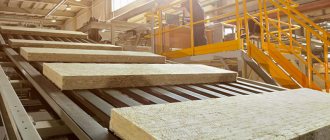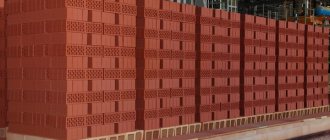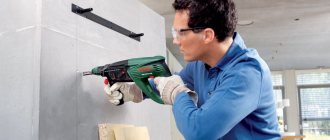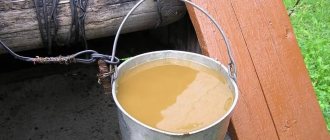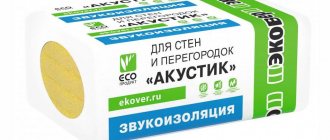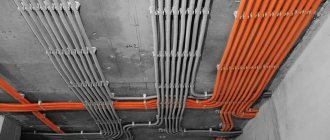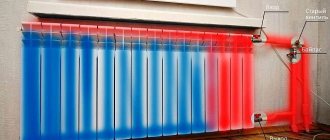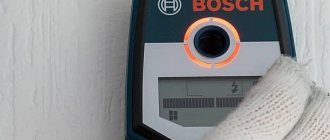The roofing materials market offers a wide range of finishing materials. Let's look at how ondulin is installed depending on the design of the roof. Let's get acquainted with the possible options for fastening elements, with their pros and cons. After reading the article with the choice of hardware and bitumen profiled sheets, there will be no difficulties; there will be practically no questions left for consultants and craftsmen.
Tinted nails for ondulin Source derevo.by
Overview of the material
Ondulin can conditionally be considered a French alternative to Soviet slate. However, their similarity is limited to their purpose - finishing roofing. The functionality is to decorate the roof and protect the under-roof space from precipitation, ultraviolet rays, birds and insects, and noise.
For the production of ondulin, a light mass of cellulose fibers, recycled cardboard and bitumen binder is used. The composition is pressed at temperatures above 120 degrees Celsius. This is where a wavy profile is formed. Mineral pigment additives are used for tinting.
The advantages of the material are:
- light weight sq. meters - within 5-6.5 kg;
- good strength - the square can withstand a weight of about a ton;
- moisture resistance, which is justified by the content of bitumen resin and water repellents;
- inertness to acidic and alkaline environments (use in industrial conditions is acceptable);
- flammability is inherent, but when heated above 200-300 degrees Celsius;
- resistance to fading due to mineral pigments;
Mineral pigments Source konturclick.ru
- ability to absorb noise.
The disadvantages include an ambiguous service life. On average it is 15 years. But in practice, failure is observed after 2 years and quality is maintained for more than half a century.
The physical parameters of the finished product look like this:
- width – 75 or 96 cm;
- length – 100 or 200 cm;
- thickness – 2.6 or 3 mm;
- wave height – 36 mm;
- covering area – up to 1.92 sq.m.
The lightweight and inexpensive material is suitable for self-painting with acrylic compounds for roofing. Ondulin is laid on slopes with a slope of up to 90 degrees. It is convenient to cover complex structures due to the flexibility of the canvas. But stretching and shrinking should be limited to 10mm.
The table provides a brief description of the 4 series that have been produced in Russia since 1994.
| Model | Dimensions | Peculiarities |
| Classical | 0.95*2 m | Suitable for slopes with a slope of 5 degrees |
| Smart | 0.95*1.95 m | The sheets have markings for fastening and have edges with a locking water barrier (Smart Lock). |
| DiY (Do It Yourself - do it yourself) | 0.75*2 m | Number of waves – 8 pieces. Increasing the number of overlaps on the coating helps to increase its overall strength. |
| Compact | 0.75*1 m, thickness 2.6 mm | Weight – 2.5 kg. Compact sheets are convenient for designing complex structures; there are fewer scraps, and mechanical stability is increased due to overlaps. |
A separate series of products is tiles. The material imitates its natural counterpart well, but is noticeably cheaper. External similarity is achieved by segmenting the wavy fabric using shadow stripes. Technically, the roof is identical to other ondulin samples.
Influence of natural factors.
There are no materials in nature that retain their original appearance over long periods of use. Exposure to water and sunlight changes the physical condition of any coatings and structures over time. When choosing, it is important to initially understand: what age is measured for your material by the manufacturer and how to maintain it in order to extend its service life.
Burnout and moss
Another area of complaint is the change in the original color or physical state of corrugated cellulose-bitumen sheets under the influence of aggressive environmental factors. These include: fading of color under the influence of ultraviolet rays or the growth of moss, especially on the north side or when the house is surrounded by trees.
I will say this, my house has now been covered with ondulin for about 20 years, there is no sunny side at all, all the paint has disappeared and the color remains black. The builders, of course, were amateurs at that time, and fastened the sheet with 5 nails. And the overhang was made 20-25 centimeters. Naturally, the snow bent the overhang slightly. I want to cover the sunny side with a new sheet. And maybe even for NDE, what do you recommend? First of all, this is a question for the manufacturer.
But before we give the floor to a specialist from the Ondulin company, I would like to note that we are talking about a roofing covering that has already served for about 20 years, even with poor-quality installation. Color fading under the influence of UV rays is typical for any coatings, unless of course they are painted in bulk. Metal tiles fade, bitumen shingles and other roofing materials change color.
The company is constantly making changes in the technological process to improve color fastness. Our factory in Nizhny Novgorod has already improved the sheet formulation several times and, as tests show, color fastness has been significantly improved. In addition, faded Ondulin can be painted with acrylic water-soluble paint for exterior use. It is also called rubber paint. The technology is as follows: the roof is cleaned, washed, dried, primed with a primer from the same manufacturer or diluted paint. Painting can be done with a spray gun or a large wide brush.
In addition to complaints about changes in the color of the coating, one often has to deal with situations where moss appears on the roof. It should be noted here that moss or lichen can appear on any roofing where a favorable nutrient medium has formed. Discussions about the presence or absence of harm from moss on the roof are ongoing. But the point here is certainly not so much a deterioration in the basic consumer characteristics of Ondulin, but a decrease in the aesthetic appeal of the roof. Common reasons for the appearance of moss is littering of the coating, which is especially typical for roofs with a slight slope and for such parts of the roof as the valley, internal break, and drainage system.
kitchen cabinet wall bracket
If the resulting vegetation causes you discomfort, then the roof covering simply needs to be cleaned with a brush with plastic bristles, being careful. To prevent the reappearance of moss, the roof can be treated with a weak chlorine-containing solution.
Is there protection from “meteorites”?
In this aspect, we will, of course, not be talking about meteorites, but about solid precipitation falling from the sky called hail. Until recently, it was generally accepted that hailstones could not damage Ondulina, and there were no mass cases confirming the destructive effects of this type of precipitation. Although economically motivated dealers of metal tiles regularly expressed their concerns to the owners of ondulin roofs. But there is a first time for everything. This is what trouble happened to a user of our portal.
Our ondulin stood for 10 years. It shed heavily on the south side, very heavily. The last hail couldn't stand it, there are five holes in the roof. In defense of ondulin, I can say that the hail was very unusual: first, crushed pieces of ice the size of a palm, then the usual smooth one, the size of a chicken egg. The crushed ice made those holes. Even the siding (!) is broken in two places. This is already force majeure; I don’t know what can withstand such a disaster. The slate was pierced, the corrugated sheeting was bent on many roofs.
If it weren’t for such an unusual hailstorm, it would have stood still for another 10 years. Just paint it. It's a pity. This roof suited us quite well. It withstood hurricane winds, downpours, and hail, but it could no longer bear these blocks of ice.
Here we can only answer that any material has a tensile strength, even concrete. And if hail the size of a small meteorite fell from the sky, then it is unlikely that any roofing will remain undamaged. Slate and natural tiles will definitely suffer. Metal roofing sheets will likely hold up, but will suffer serious dents and future rust spots. At the same time, punctured Ondulin can be easily repaired and, if desired, you don’t even have to change the roof. In any case, the number of such incidents is negligible and is within the statistical error.
Fastener selection
To fix the canvas, the French company produces analogue nails for ondulin. Warranty obligations do not apply to roofs installed using other fasteners. The constructive solution of suitable elements is as follows:
- Rod . Made from carbon steel, the workpieces are coated with a thin layer of zinc alloy to protect against corrosion. The edges are equipped with threads for reliable fixation of the nail in the body of the wooden sheathing.
- Pad . Made from hard rubber. It has a curved shape to follow the roof topography. This ensures that the seal fits as tightly as possible to seal the hole.
- Hat . Molded from hard (impact-resistant) plastic (PVC or polypropylene based). It has a relatively large diameter to prevent the fabric from tearing off in strong winds. The task is also to protect the rod from aggressive environmental conditions.
Nail for ondulin Source petrovich.ru
The dimensions of the fasteners are standardized. The length is 7-7.5 cm, the cross-sectional diameter of the rod is 3.55 mm. To visually hide the nails against the background of the roofing sheet, the protruding parts are painted with polymer compounds to match the color of ondulin.
See also: Catalog of companies that specialize in roofing work
Nails with plugs
For a long time, it was possible to purchase nails with decorative caps from the manufacturer. Structurally, the plastic product consists of a sole and a plug, which are connected to each other by a thin polymer thread. The first part is an alternative to the gasket, the second serves as protection for the metal nail head.
To install ondulin tiles, you need to perform 3 steps. First, the rod is inserted into the hole in the sole, then the fasteners are hammered into the sheathing until it fits snugly against the ondulin. The final step is to close the hole with a cap until you hear a characteristic click.
Some specialists refuse such hardware. The reason is the high percentage of defective products that do not close. The solution to the problem is to purchase caps with a reserve. Another option is to heat the plastic in hot water. But here you will need to be patient, since on average there are about 1000 nails on the roof of a small house. The third approach is the choice of analog products.
Blank caps Source stblizko.ru
Nails with a monolithic head
Domestic caps have developed fasteners in a continuous design. Here the upper part of the nail is molded in the shape of a hat with a not very wide brim. Technically, the products are similar to roofing screws, only the rod has a ring rather than a spiral notch.
It is recommended to load such fasteners in two stages. First, hammer until the cap touches the ondulin. Then, without strong pressure, press the canvas against the sheathing and finish off the nail a little. This ensures a tight fit of the cap brim to the roofing material.
Often the protective coating of the cap is damaged. Here are some reasons:
- excessive force on the cap (a cap that does not snap into place);
- low quality of decorative coating on hardware;
- the nail is driven in at a deviation of 90 degrees in relation to the sheathing.
To avoid having to pull out the nail (this can lead to damage to the roofing), you need to eliminate the listed phenomena. Also, damage prevention is considered to include maximum preservation of the given shape of the ondulin web. Excessive stretching or compression of the sheet leads to deformation of the sheet, which means a tight fit to the sheathing cannot be achieved without violating the fixation rules.
Tight fit of the gasket Source ytimg.com
Self-tapping screws for ondulin
Foreign craftsmen practice fastening ondulin with self-tapping screws. They are also equipped with a washer, which, along with the cap, is tinted to match the color of the coating. Such fasteners are convenient due to the ability to mechanize the process. Here it is permissible to use a screwdriver or an electric drill. The number of hardware is the same as the number of nails needed for a sheet of ondulin.
The main advantage is the use of hardware for metal sheathing. Such self-tapping screws are made with a drill bit. That is, you don’t have to drill the seat before screwing it in. Nails cannot be driven into metal.
The second advantage of use is the possibility of reusable dismantling of the fastening. Pulling out nails with a ring notch is a difficult task. Alternative hardware, if the fixation came out of tension, can be easily unscrewed and put back in without affecting the quality of the final work.
But there is one significant drawback. On the domestic market, roofing screws for ondulin are equipped with flat washers. They do not evenly adhere to the ondulin, which means the joint is leaky. Some craftsmen solve the problem with the help of additional rubber gaskets.
Self-tapping screw for ondulin Source allegroimg.com
Branded Fasteners
Incorrect selection of fasteners will inevitably lead to a decrease in the performance characteristics of the roofing structure. One strong gust of wind can tear off a fragment of building material, and rainwater easily penetrates under the roof.
Another fastener design option
Most experts advise using special screws. These products are quite durable and reliable, since high-quality raw materials are used in their production. Also, self-tapping screws can be screwed in using an electric drill, which makes installation much faster. With all these qualities, the products are quite cheap.
But self-tapping screws also have a significant drawback - they are not able to provide complete tightness, despite the presence of a rubber tip, which partially mitigates this drawback.
Nails for installing ondulin fragments also have all of the above advantages, but a drill is not suitable for their installation. At the same time, nails ensure the tightness of the structure. This was achieved in the following way: when the fastener penetrates the sheet, bitumen is released, which fills the voids and does not allow water to penetrate inside.
Return to content
Video description
The video presents the user's opinion on what is better: nails or self-tapping screws:
Hidden installation
To attach ondulin to the sheathing, the practice is to fix the sheets with staples and polyurethane foam. The first ones are installed along the transverse edges at the bottom of the wave and attached to a wooden beam. The second is applied pointwise to the outer part at the upper points of the profile and covered with a subsequent sheet of roofing material. This method is practical, since due to the overlaps, additional sealing is not required, and the integrity of the canvases is not compromised. A similar fastening system is provided for natural tiles.
History of appearance
Material of French origin.
Inventor: Gaston Gromier.
It was first released in the middle of the last century, when, after the end of the war in Europe, it was necessary to quickly and cheaply restore destroyed buildings.
The name “ondulin” (spelled this way, not “andulin” or “indulin”) is the same name of a company that produced roofing material.
Then it caught on and went to the masses as a common noun. In Russia, the first factories for the production of this material appeared in the mid-90s.
Installation technology
To cut bitumen sheets, you can use a regular hacksaw for wood.
To prevent the blade of a hand tool from getting stuck due to the bitumen binder, it is lubricated with oil. For a large object, craftsmen use a circular electric saw.
Cutting the canvas Source valenteshop.ru
Overview of support systems
A support base is formed on the rafter system from a continuous or sparse sheathing. The table discusses technical features depending on the slope of the roof slope.
| Slope (degrees) | Lathing type | Add-ons |
| To 10 | Solid | The first row is fastened at a distance of 3.5 cm from the overhang. The longitudinal overlap of the canvases is 2 waves, the end overlap is 30 cm. The hardware is placed in three rows. |
| 10-15 | In 45 cm increments | The overhang is the same. Lateral overlap - 1 wave, transverse - 20 cm. Fastening the fabric in 4 rows. |
| From 15 | In 61 cm increments | The light is identical. The overlaps are 1 wave and 17 cm. Three-row fastening position. |
Common mistakes
In order for your ondulin roof to serve for a long time and reliably, it is important to follow all recommendations for the selection and installation of materials.
The causes of problems during operation may be the following:
- Choice of material. Stay with trusted ondulin manufacturers. Cheap analogues will help you save not such a large amount at a time, but the cost of correction will be much more expensive. Official manufacturers of materials also produce a complete set of all consumables necessary for installation.
- The installation technology is broken. Ondulin is a material that can be installed independently. But at the same time, it is necessary to strictly follow all instructions and requirements. Pay attention to the preparatory work and do not neglect safety precautions.
- The junctions of the roofing covering with various elements - the ventilation system, air ducts, pipes, elements of the smoke removal system, etc. - are poorly executed. When carrying out work, it is necessary to pay special attention to sealing all joints to prevent precipitation from entering.
Installation of ondulin over an old roof
Since ondulin weighs little and is simply attached, it is often used to update old roof coverings without dismantling it. Such a roofing sheet can serve as a supporting base for a new finish. The procedure looks like this:
- removing debris, removing the ridge and weak pieces of old covering;
- repair or replacement of load-bearing structural elements;
- arrangement of cellular sheathing: bars along the rafters, with crossbars on them for attaching ondulin to the roof;
- installation of an additional beam under the ridge (10 cm from the top);
- pulling the drainage system.
Next, the installation of ondulin is carried out by analogy with the installation of a new roof. Additionally, from the remnants of the canvases, you can form the cladding of the gable part of the roof. It's practical and inexpensive. The lathing is assembled in cellular form.
Advantages and disadvantages of self-tapping screws
Surely, every developer strives to find out as many nuances as possible about this or that element. In some cases, this allows you to assess the situation more sensibly and do the job much better. When working with self-tapping screws, it is worth highlighting one very important feature: installation speed. If you use power tools, the installation speed reaches very high levels, which cannot be said about ordinary nails, where caution is paramount.
Self-tapping screws can be used both on wooden and metal sheathing, although ondulin is rarely installed on such a base. The consumption of hardware and their attachment location is no different from nails, so it makes no sense to talk about it.
In addition to the positive aspects, there are also some negative aspects. The gasket included in the fastener does not allow for 100% sealing due to the shape of the coating itself. It follows from this that during operation of such a roof some amount of moisture will still get into it. This problem can be dealt with using special roofing sealants, but this will significantly prolong the installation process.
For some people, the appearance of a building plays a rather important role. Using self-tapping screws as fasteners, it is not always possible to guess the color scheme for the reason that their caps are not made in different colors, they have a standard color scheme.
Properties of Euroslate
Like any other building material, ondulin has pros and cons that determine its use.
Positive sides:
- light weight - one sheet weighs about 6 kg, this makes it easy for even one person to work with it, plus, ondulin does not create a large load on the roofing system;
- attractiveness - the roof looks neat, bright, making a pleasant impression;
Samples of ondulin of different colorsSource fotocdn.net
- water resistance - bitumen has practically no pores, does not allow water to pass through, its waterproofing qualities are very high;
- biological inertness - due to the fact that the liquid does not penetrate the bitumen, as happens with slate or tiles, moss does not appear on it during the entire service life of the roofing;
- simplicity and speed of installation - due to the lightness of the sheets of material, even one person can install them; delivering them to the work site does not cause difficulties;
- optimal thickness - the thickness of the sheets is 3 mm, this is enough for the necessary strength and water resistance;
- long service – a profiled bitumen coating can last for decades; if installed correctly, such a roof will not require replacement for about 50 years; the manufacturer usually gives a 15-year warranty;
- low cost - Euro slate is one of the most inexpensive roofing materials; it is often used in cases where they want to build budget housing;
- flexibility - thanks to this property, the sheets are not afraid of impacts, you can step on them and they will not suffer; softness simplifies installation and allows, if necessary, to slightly stretch or narrow the waves;
Ondulin has good flexibilitySource obyava.ua
- strength - the roof is able to withstand the weight of thick snow cover, heavy rain, hail;
- sound insulation – a valuable quality is silence during heavy rain or hail, corrugated sheets and metal tiles make a loud noise under such influence, tiles and slate make a loud noise, Euro slate makes almost no sound; in addition, it reduces the noise level from the street, this is valuable if the house has a residential attic.
To understand what roof ondulin is and how durable it is, it is worth recalling that the manufacturer claims that this material, when carefully and competently installed, can withstand hurricane winds of up to 192 km/h. True, doubts arise whether the roof itself can withstand such a wind. We hope that no one will have to test the wind resistance of the roof of their home in practice.
Thick layer of snow on the roofSource spb-k.ru
As mentioned above, an ondulin roof has pros and cons, so it is worth dwelling in detail on the negative qualities of the material. Among them:
- poor resistance to frost - in severe cold, bitumen becomes brittle and can crack; in such weather it is better not to move the product or clean the snow on the roof; for this reason, it is better not to use the coating in northern regions, where very low temperatures are common in winter, especially if they last for a long time;
- flammability - resins and cellulose are flammable substances, so some owners are afraid to use ondulin for fear of fire;
- fading - the color of the roof tends to fade over time under the influence of the sun; this applies less to the original ondulin and more to its analogues from other manufacturers.
The budget price of Euro slate can be considered both a plus and a minus. Some developers do not use this material only because they consider its use to be unprestigious.
The use of ondulin is limited to social facilities, including medical institutions, schools, kindergartens, and boarding schools.
When arranging roof connections to pipes, you need to be careful with bituminous materials, because they can leak from heat. The original Onduline has a formulation that allows it to withstand temperatures greater than 100 degrees Celsius, but not higher than 250 degrees. Therefore, the sheets are not laid close to the pipes, leaving a gap; the junctions are closed with special elements made of non-combustible materials or metal.
Arrangement of a reliable connection of the roofing covering to the chimneySource stroyfora.ru
There are often statements that ondulin is short-lived and becomes unusable after 10-20 years of service. This is wrong. The fault is poor-quality installation, saving on lathing or buying fakes.
A detailed analysis of the shortcomings is important for understanding what ondulin is and what it is made of. Comparing its advantages and disadvantages helps to understand whether this material is worth using at all.
Laying rules
In order for the roof to be warm, protected from moisture, and for the coating to look great for many seasons in a row, it is necessary to correctly install ondulin sheets. Work is carried out at temperatures not exceeding 30 degrees. Otherwise, the material softens, deforms, and becomes sticky. But it cannot be installed in the cold either, since ondulin tends to crack at subzero temperatures. In general, like any other roofing work, this must be carried out under comfortable weather conditions.
In its structure, ondulin is very similar to slate, only it has many more useful properties and advantages. The wavy structure promotes the most efficient drainage of moisture and also increases the rigidity of the sheet. Sheets can only be installed on a pitched roof; the material is not suitable for flat roofs. Most often, such coating is used for summer cottages and private houses.
The installation of lathing when covering with ondulin is considered mandatory. It helps to avoid unnecessary deformation of the sheets and allows for additional insulation of the roof. To save material, you should not attach stretched sheets, since they will be deformed due to temperature changes and, most likely, it will be necessary to cover the entire surface.
Wooden sheathing is easy to install. In addition, it is an environmentally friendly and well-insulated material. Most owners use wooden sheathing when laying ondulin. The metal profile frame is lighter, but no less durable. It is also able to prevent ondulin sheets from deformation. For such a sheathing you will need a grinder and metal screws with a plastic head.
You should not walk a lot on the installed areas: ondulin is quite soft, but if you have to do this, then when installing sheets on already attached ones, you should step on the upper crests of the wave. To cut sheets across the waves, it is better not to use a ruler - this is quite inconvenient, but to cut yourself a pattern from another fragment of the sheet, preferably of a different color. This way the waves fit together and it’s easier to mark them. The material is cut very easily both lengthwise and crosswise, however, for safety it is better to mark all the necessary fragments in advance and cut them off after going down to the ground.
For special nails or screws with colored plastic heads, just use a regular hammer. The material itself, due to its softness, is very easy to pierce, so a lot of diligence is not required, you need to work carefully. The nail must be driven into the crest of the wave perpendicularly to the end, slightly pressing the head. The correct way would be to secure the two outer waves first, then in the middle, then the rest. It is wrong to nail each wave one by one.
Briefly about the main thing
Ondulin is a roofing material made from cellulose fibers impregnated with bitumen and mineral pigments.
Installation is carried out on solid or sparse sheathing on rafters or old covering.
For fastening to the top point of the wave, nails with a ring notch or self-tapping screws are used. There must be a sealing washer or cap with a sole.
Read later
We will send the material by email
Order finishing work of any complexity from professionals
Submit your application
